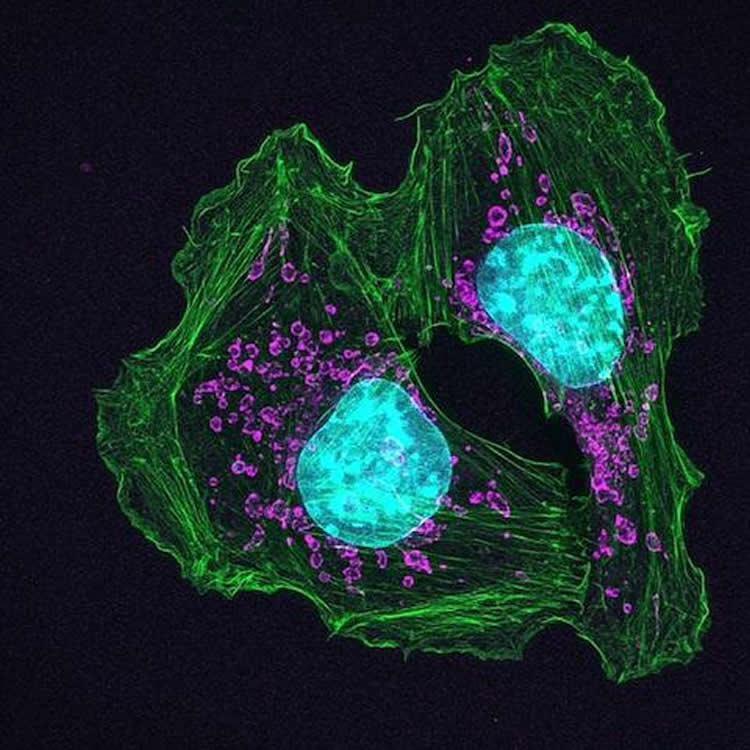Summary: According to a Cell Reports study, mice with abnormal eating schedules are more likely to develop skin cancer cells. Researchers report abnormal eating times disrupt the skin’s circadian cycle and weakens the potency of an enzyme that protects against UV rays.
Source: UT Southwestern Medical Center.
Sunbathers may want to avoid midnight snacks before catching some rays.
A study in mice from the O’Donnell Brain Institute and UC Irvine shows that eating at abnormal times disrupts the biological clock of the skin, including the daytime potency of an enzyme that protects against the sun’s harmful ultraviolet radiation.
Although further research is needed, the finding indicates that people who eat late at night may be more vulnerable to sunburn and longer-term effects such as skin aging and skin cancer, said Dr. Joseph S. Takahashi, Chairman of Neuroscience at UT Southwestern Medical Center’s Peter O’Donnell Jr. Brain Institute.
“This finding is surprising. I did not think the skin was paying attention to when we are eating,” said Dr. Takahashi, also an Investigator with the Howard Hughes Medical Institute.
The study showed that mice given food only during the day – an abnormal eating time for the otherwise nocturnal animals – sustained more skin damage when exposed to ultraviolet B (UVB) light during the day than during the night. This outcome occurred, at least in part, because an enzyme that repairs UV-damaged skin – xeroderma pigmentosum group A (XPA) – shifted its daily cycle to be less active in the day.
Mice that fed only during their usual evening times did not show altered XPA cycles and were less susceptible to daytime UV rays.
“It is likely that if you have a normal eating schedule, then you will be better protected from UV during the daytime,” said Dr. Takahashi, holder of the Loyd B. Sands Distinguished Chair in Neuroscience. “If you have an abnormal eating schedule, that could cause a harmful shift in your skin clock, like it did in the mouse.”
Previous studies have demonstrated strong roles for the body’s circadian rhythms in skin biology. However, little had been understood about what controls the skin’s daily clock.
The latest research published in Cell Reports documents the vital role of feeding times, a factor that scientists focused on because it had already been known to affect the daily cycles of metabolic organs such as the liver.
The study found that besides disrupting XPA cycles, changing eating schedules could affect the expression of about 10 percent of the skin’s genes.

However, more research is needed to better understand the links between eating patterns and UV damage in people, particularly how XPA cycles are affected, said Dr. Bogi Andersen of University of California, Irvine, who led the collaborative study with Dr. Takahashi.
“It’s hard to translate these findings to humans at this point,” said Dr. Andersen, Professor of Biological Chemistry. “But it’s fascinating to me that the skin would be sensitive to the timing of food intake.”
Dr. Takahashi, noted for his landmark discovery of the Clock gene regulating circadian rhythms, is researching other ways in which eating schedules affect the biological clock. A study earlier this year reinforced the idea that the time of day food is eaten is more critical to weight loss than the amount of calories ingested. He is now conducting long-term research measuring how feeding affects aging and longevity.
Funding: The UV study was supported by the Irving Weinstein Foundation, the National Institutes of Health, the China Scholarship Council, and the National Science Foundation Graduate Research Fellowship.
Source: James Beltran – UT Southwestern Medical Center
Image Source: NeuroscienceNews.com image is credited to Knight Cancer Institute.
Original Research: Full open access research for “Time-Restricted Feeding Shifts the Skin Circadian Clock and Alters UVB-Induced DNA Damage” by Hong Wang, Elyse van Spyk, Qiang Liu, Mikhail Geyfman, Michael L. Salmans, Vivek Kumar, Alexander Ihler, Ning Li, Joseph S. Takahashi, and Bogi Andersen in Cell Reports. Published online August 1 2017 doi:10.1016/j.celrep.2017.07.022
[cbtabs][cbtab title=”MLA”]UT Southwestern Medical Center “Eating Habits Affect Skin’s Protection Against Sun.” NeuroscienceNews. NeuroscienceNews, 15 August 2017.
<https://neurosciencenews.com/eating-habit-skin-protection-7310/>.[/cbtab][cbtab title=”APA”]UT Southwestern Medical Center (2017, August 15). Eating Habits Affect Skin’s Protection Against Sun. NeuroscienceNew. Retrieved August 15, 2017 from https://neurosciencenews.com/eating-habit-skin-protection-7310/[/cbtab][cbtab title=”Chicago”]UT Southwestern Medical Center “Eating Habits Affect Skin’s Protection Against Sun.” https://neurosciencenews.com/eating-habit-skin-protection-7310/ (accessed August 15, 2017).[/cbtab][/cbtabs]
Abstract
Time-Restricted Feeding Shifts the Skin Circadian Clock and Alters UVB-Induced DNA Damage
Highlights
•Restricted feeding (RF) alters the phase and amplitude of the skin circadian clock
•Food intake acutely alters the expression of many genes in the skin
•RF affects the rate but not the phase of epidermal progenitor diurnal proliferation
•Daytime RF reverses diurnal sensitivity to UVB-induced DNA damage
Summary
The epidermis is a highly regenerative barrier protecting organisms from environmental insults, including UV radiation, the main cause of skin cancer and skin aging. Here, we show that time-restricted feeding (RF) shifts the phase and alters the amplitude of the skin circadian clock and affects the expression of approximately 10% of the skin transcriptome. Furthermore, a large number of skin-expressed genes are acutely regulated by food intake. Although the circadian clock is required for daily rhythms in DNA synthesis in epidermal progenitor cells, RF-induced shifts in clock phase do not alter the phase of DNA synthesis. However, RF alters both diurnal sensitivity to UVB-induced DNA damage and expression of the key DNA repair gene, Xpa. Together, our findings indicate regulation of skin function by time of feeding and emphasize a link between circadian rhythm, food intake, and skin health.
“Time-Restricted Feeding Shifts the Skin Circadian Clock and Alters UVB-Induced DNA Damage” by Hong Wang, Elyse van Spyk, Qiang Liu, Mikhail Geyfman, Michael L. Salmans, Vivek Kumar, Alexander Ihler, Ning Li, Joseph S. Takahashi, and Bogi Andersen in Cell Reports. Published online August 1 2017 doi:10.1016/j.celrep.2017.07.022






